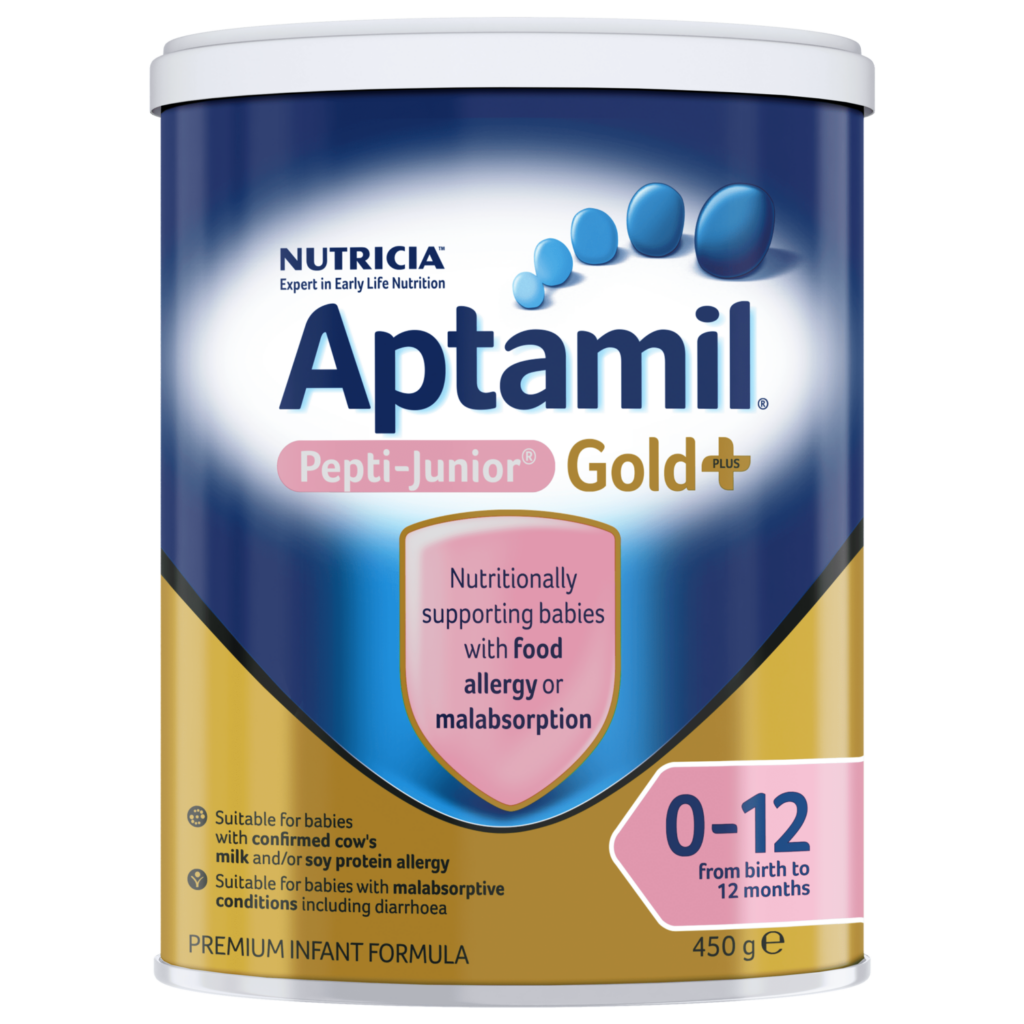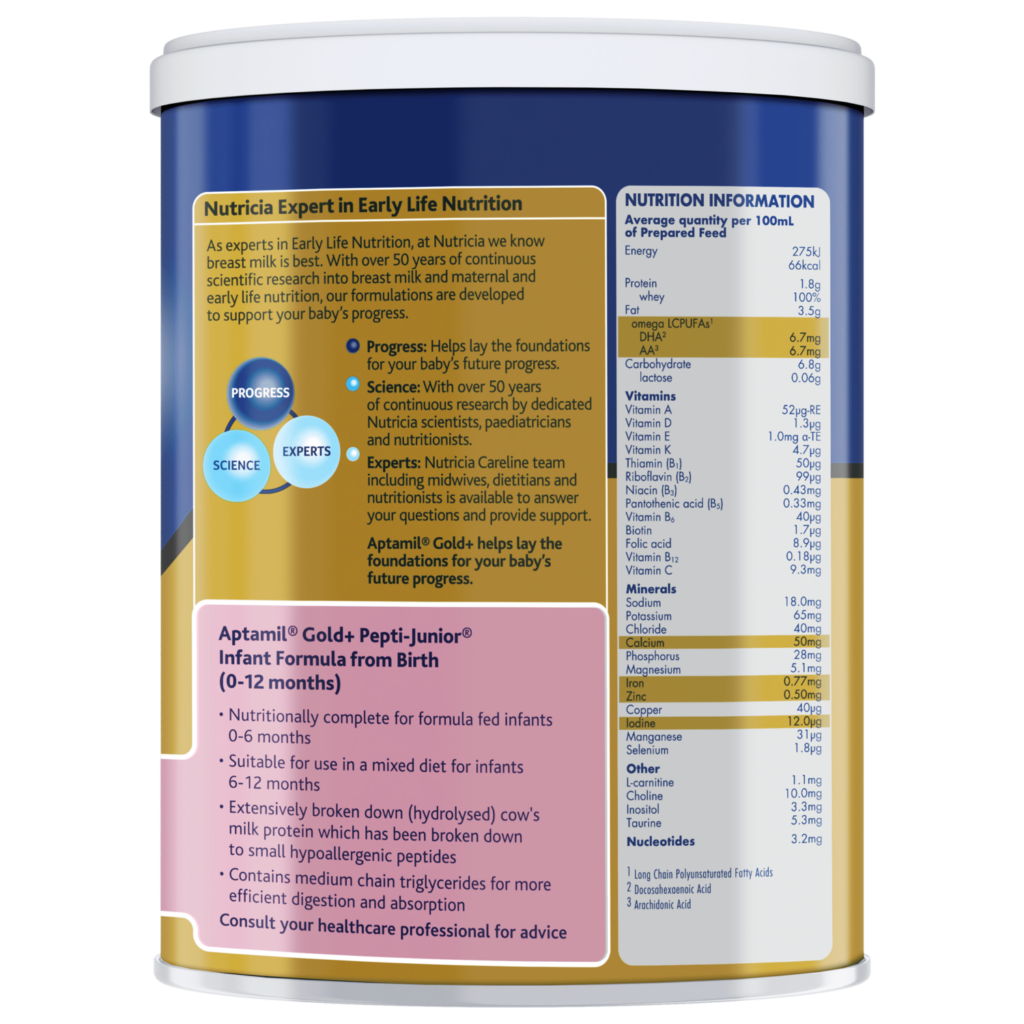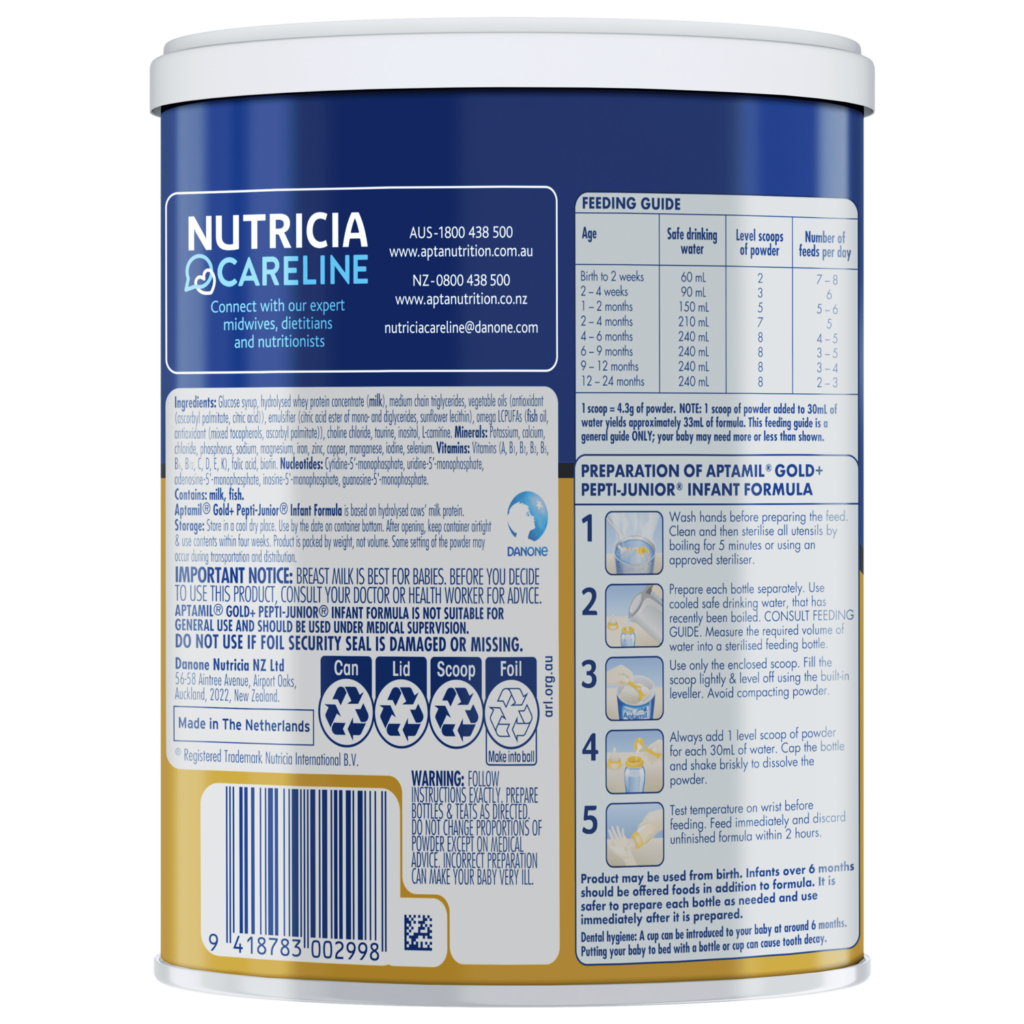


Product Information
Aptamil® Gold+ Pepti-Junior® is a premium, extensively hydrolysed infant formula (eHF) with short chain peptides, specific fat blend with medium chain triglycerides (MCT), omega 3 and omega 6 LCPs#, and low osmolality. Available on PBS.
Features
- An easy to digest fat blend including MCT.##1
- Low osmolality.
- <0.1g lactose per 100mL of feed.
- Low allergenicity with intact cows’ milk protein broken down to small hypoallergenic peptides (extensively hydrolysed). This makes Aptamil® Gold+ Pepti-Junior® suitable for infants with food allergies and intolerances such as cows’ milk and soy protein allergy.
- An extensively hydrolysed formula (eHF) such as Aptamil® Gold+ Pepti-Junior® is recommended as the first choice for infants under 6 months of age, for treating mild to moderate cows’ milk protein allergy.2,3
- An eHF provides effective management of up to 90% of infants with uncomplicated mild to moderate cows’ milk protein allergy.4,5 If treatment with this initial formula is not successful, use of an amino acid formula (AAF) such as Neocate is recommended.2,4
- Vitamins and minerals to support infant growth and development.
- Omega 3 DHA to support brain and eye development. 6-8
Contraindications for use
Allergy to extensively hydrolysed cows’ milk formula, severe (anaphylactic) cows’ milk protein allergy, galactosemia and primary lactose intolerance.
Direction of Use
- Wash hands before preparing the feed. Clean and then sterilise all the utensils by submerging bottles and teats in water and boiling for 5 minutes, or using an approved steriliser.
- Boil safe drinking water and allow to cool. Measure the required volume of water into a sterilised feeding bottle.
- Use only the enclosed scoop. Fill the scoop lightly and level off using the built-in leveler. Avoid compacting powder.
- Always add one level scoop of powder for each 30mL of water. Stir or shake briskly to dissolve the powder.
- Test temperature on wrist before feeding. Feed immediately (do not store). Discard unfinished feeds.
Prepare each bottle separately. For all brands of formula, it is safer to use immediately after they are prepared. Product is packed by weight, not volume. Some settling of the powder may occur during transportation and distribution.
Storage
- Store in a cool, dry place.
- Use by the date on bottom of the container.
- After opening, keep container airtight and use contents within four weeks.
- Some settling of the powder may occur.
Feeding Guide
| Age | Cooled boiled water | Level scoops of powder* | Number of feeds per day |
|---|---|---|---|
| Up to 2 weeks | 60mL | 2 | 7 – 8 |
| 2 weeks to 1 month | 90mL | 3 | 6 |
| 1 to 2 months | 150mL | 5 | 5 – 6 |
| 2 to 4 months | 210mL | 7 | 5 |
| 4 to 6 months | 240 mL | 8 | 4 – 5 |
| 6 to 9 months | 240 mL | 8 | 3 – 5 |
| 9 to 12 months | 240 mL | 8 | 3 – 4 |
| 12 to 24 months | 240 mL | 8 | 2 – 3 |
*1 scoop = 4.3g of powder. NOTE: 1 scoop of powder added to 30mL of water yields approximately 33.3 mL of formula. This feeding guide is a general guide ONLY.
Allergen and Cultural Information
Contains cows’ milk and fish.
Nutritional Information
| Average contents | Per 100 mL |
|---|---|
| NUTRITION INFORMATION | |
| Energy | 277 kJ |
| 66 kcal | |
| Protein | 1.8 g |
| Whey | 100 % |
| Carbonhydrate | 6.8 g |
| Lactose | <0.1 g |
| Total Fat | 3.5 g |
| — Saturated | 1.9 g |
| — medium chain triglycerides | 1.6 g |
| Omega LCPUFAs<sup>a</sup> | |
| Arachidonic Acid (AA) | 6.7 mg |
| Docosahexaenoic Acid (DHA) | 6.7 mg |
| MINERALS | |
| Calcium | 50 mg |
| Potassium | 65 mg |
| Phosphorus | 28 mg |
| Sodium | 18 mg |
| Magnesium | 5.1 mg |
| Chloride | 40 mg |
| Iron | 0.77 mg |
| Zinc | 0.50 mg |
| Copper | 40 μg |
| Manganese | 31 μg |
| Selenium | 1.8 μg |
| Iodine | 12 μg |
| VITAMINS | |
| Vitamin A | 52 μg-RE |
| Vitamin D | 1.3 μg |
| Vitamin E | 1.0 mg |
| Vitamin K | 4.7 μg |
| Thiamin (B~1~) | 50 μg |
| Vitamin B~2~ | 99 μg |
| Vitamin B~6~ | 40 μg |
| Vitamin B~12~ | 0.18 μg |
| Niacin (B~3~) | 0.43 mg |
| Folate | 8.9 μg |
| Vitamin C | 9.3 mg |
| Biotin | 1.7 μg |
| Pantothenic Acid (B~5~) | 0.33 mg |
| OTHERS | |
| Choline | 10.0 mg |
| Taurine | 5.3 mg |
| Inositol | 3.3 mg |
| L-carnitine | 1.1 mg |
| NUCLEOTIDES | |
| Cytidine-5′-monophosphate | 1.1 mg |
| Uridine-5′-monophosphate | 0.77 mg |
| Adenosine-5′-monophosphate | 0.67 mg |
| Inosine-5′-monophosphate | 0.45 mg |
| Guanosine-5′-monophosphate | 0.23 mg |
| aLong chain polyunsaturated fatty acids |
Ingredients
Glucose syrup, hydrolysed whey protein concentrate (contains milk), medium chain triglycerides, vegetable oils (antioxidant (ascorbyl palmitate, citric acid)), maltodextrin, emulsifier (citric acid ester of mono- and diglycerides, sunflower lecithin)), omega LCPUFAs (contains fish, antioxidant (mixed tocopherols, ascorbyl palmitate)), choline chloride, taurine, inositol, L-carnitine.
References
- Bach et al. Am J Clin Nutr 1982; 36:950-962.
- Kemp A et al. MJA 2008;188(2):109–112.
- ASCIA Information for patients, consumers and carers. Cows Milk Allergy 2019.
- Vandenplas Y et al. Arch Dis Child 2007;92:902–908.
- Koletzko B et al. J Perinat Med 2008; 36:5–14.
- Birch et al. Am J Clin Nutr 2010; 91: 848–859.
- Innis S et al. J Pediatr Gastroenterol Nutr 2009; 48:S16–S24
## MCT/LCT = Medium Chain Triglycerides/Long Chain Triglycerides.
